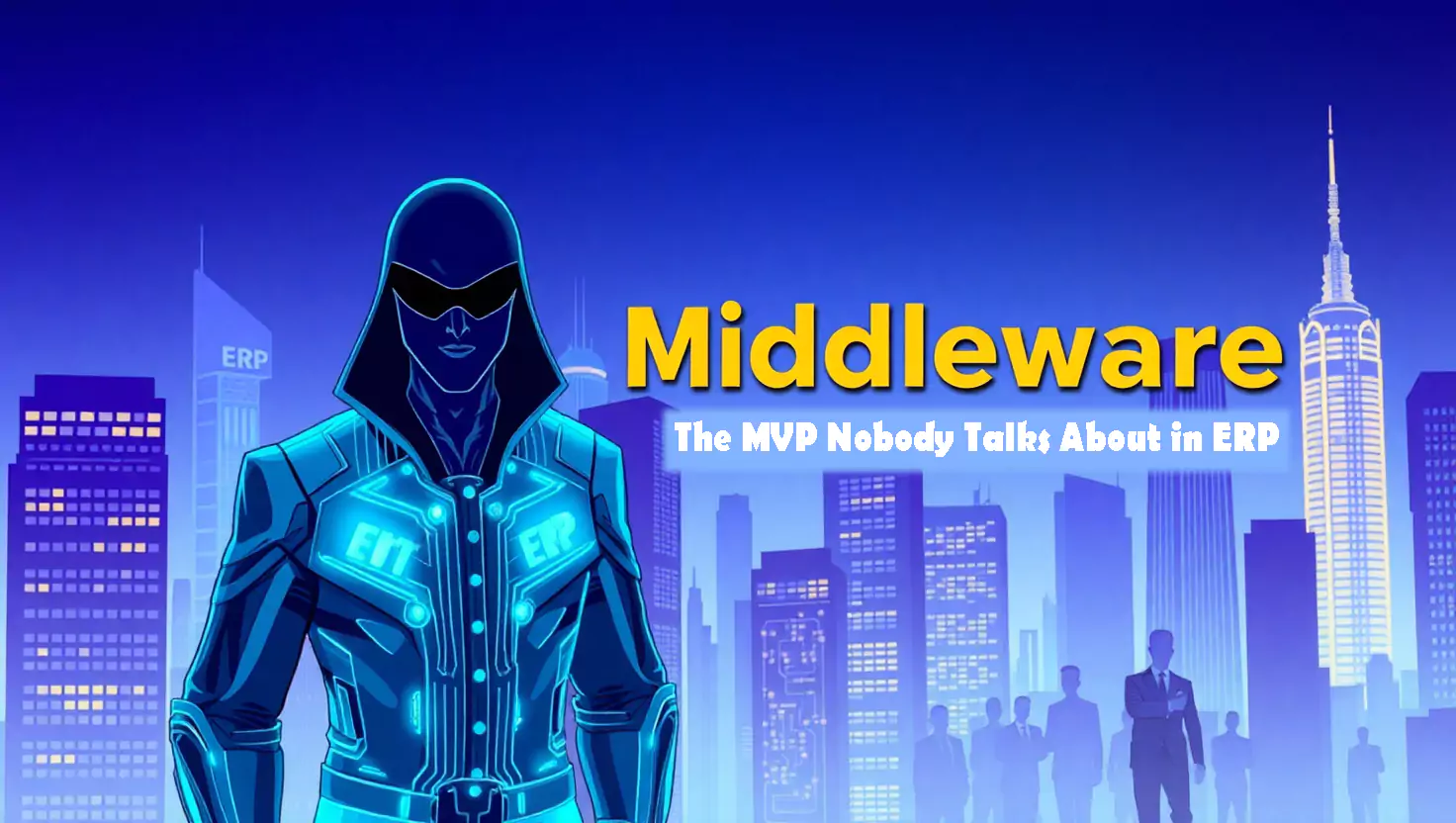Introduction: Middleware, the Unsung Hero
Let’s not sugarcoat it—middleware isn’t winning any popularity contests, but it’s seriously the glue that keeps your whole ERP operation from falling apart. If you’ve ever tried to get your crusty old inventory app to swap info with that shiny new HR tool, you already know: without middleware, you’re basically doomed to a world of late nights and random system meltdowns.
What Is Middleware?
Imagine an extremely inebriated interpreter at a tumultuous global summit. By translating all of the strange dialects, middleware leaps right in the middle and transforms a confusing room into a conversation that can be carried on. It ensures that they are all exchanging information without exploding, regardless of whether you are juggling ERP, HRM, CRM, eCommerce, or some other legacy app.
Where Do You Actually Use Middleware?
Honestly, anywhere you’ve got two business systems that need to cooperate but speak totally different languages. Some classic scenarios:
- ERP meets CRM: So your customer updates don’t vanish into the abyss.
- HRM syncs with Payroll: Because HR yelling at accounting is never fun.
- eCommerce orders talk to Inventory: To stop you from selling stuff you don’t have (seriously, don’t do it).
- Supply Chain data gets to Finance: So the beancounters don’t lose their minds.
And let’s be real—every time you add a new tool, middleware’s the one making sure it doesn’t break everything else.
What Does Middleware Actually Do?
Middleware isn’t just shuffling data around. It comes with a toolkit that’s way more than just basic message delivery. Here’s what’s really going on:
Data Transformation
Takes raw info from one system, gives it a makeover, and hands it off so the next system actually “gets” it. Like converting your grandma’s scribbled recipe into a viral Instagram post—same content, just way more readable.
Protocol Bridging
REST, SOAP, weird old FTP jobs—middleware doesn’t flinch. It just jumps between them, so you don’t have to care what language your apps are yelling in.
Workflow Automation
Nobody’s got time for triple data entry. Middleware hits that “easy button,” automatically updating all your systems when something important happens. Less grunt work, fewer mistakes.
Error Handling
Stuff’s gonna break sometimes—that’s just life. Middleware catches the flubs, flags the weirdness, and sometimes even patches it up before anyone notices. It’s kinda like having a mini IT superhero.
Security Layer
Not just about moving info around. Middleware’s also standing guard—handling logins, permissions, encryption, the works. So the only people seeing your data are the ones who’re actually supposed to.
Some Middleware Heavyweights (a.k.a. Usual Suspects)
The middleware world’s got a few big players, each with their own vibe:
- MuleSoft Anypoint Platform
Super flexible, plugs into just about anything, and people swear by it. - Dell Boomi
Lives in the cloud, really user-friendly, gets integrations up and running fast. - Apache Camel
Open-source, which means you can mess around under the hood if you’re into that sort of thing. - IBM WebSphere
Ancient in tech years, but still rock-solid for those mega-sized companies. - Microsoft Power Automate
If you’re deep in the Microsoft ecosystem, this one’s a no-brainer for automating boring stuff.
Why Bother With Middleware? (Seriously)
Because, honestly, trying to connect your business apps without middleware is like trying to herd cats—blindfolded. Here’s what you actually get out of using it:
- Shorter Development Time
You’re not re-inventing the wheel every time two apps need to talk. Plug, play, done. - Reduced Complexity
Middleware handles the gnarly details—protocols, formats, handshakes—so your devs can actually work on stuff that matters. - Reliability & Scalability
Everything’s smoother and way less likely to crash. Plus, when it’s time to add new tools, you’re not rebuilding from scratch. - Real-Time & Batch Processing
Need instant updates? Cool. Prefer nightly batch jobs? Also cool. Middleware’s flexible like that. - Faster Rollouts
Integrations go live quicker, which means your execs stop bugging you every five minutes about launch dates. - Extended Insights
With all your systems finally talking, you actually get a big-picture view of what’s going on—a rarity in most companies.
Why Middleware’s More Important Than Ever
Every year, businesses are piling on more cloud apps and dusting off even more legacy systems. Integration’s turning into this monster puzzle, and the stakes are way higher than they used to be. Middleware isn’t just about shoving data from point A to point B anymore. Now it’s running your workflows, crunching analytics, and even helping AI do its thing. The whole “API-first” and “microservices” trend? Middleware’s the engine that keeps all that running.
Wrapping It Up: Middleware or Bust
Bottom line? Middleware is the unsung hero making sure your ERP doesn’t turn into a digital island. It’s the translator, the fixer, the automation wizard, and the security guard—basically, the backbone of any decent integration. Ignore it, and you’re stuck in tech chaos. Use it, and suddenly everything plays nice. That’s honestly the difference between business as usual and business on fire (in the bad way).
